Melanoma, the most serious type of skin cancer, develops in the cells (melanocytes) that produce melanin — the pigment that gives your skin its color. Melanoma can also form in your eyes and, rarely, inside your body, such as in your nose or throat.
The exact cause of all melanomas isn't clear, but exposure to ultraviolet (UV) radiation from sunlight or tanning lamps and beds increases your risk of developing melanoma. Limiting your exposure to UV radiation can help reduce your risk of melanoma.
The risk of melanoma seems to be increasing in people under 40, especially women. Knowing the warning signs of skin cancer can help ensure that cancerous changes are detected and treated before the cancer has spread. Melanoma can be treated successfully if it is detected early.
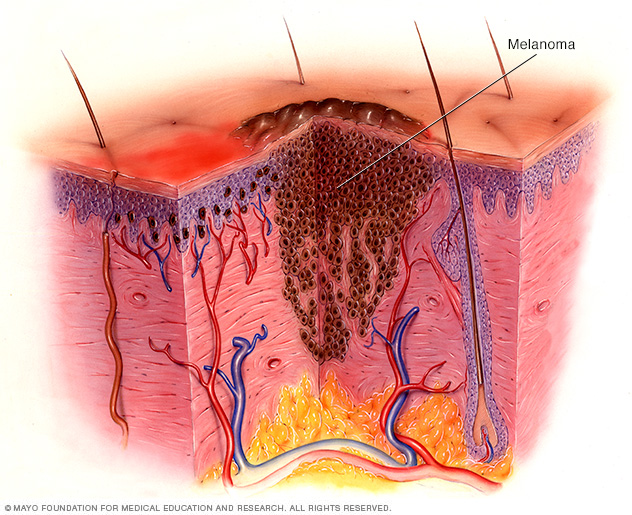
Melanoma is a form of skin cancer that begins in the cells (melanocytes) that control the pigment in your skin. This illustration shows melanoma cells extending from the surface of the skin into the deeper skin layers.
Symptoms
Melanomas can develop anywhere on your body. They most often develop in areas that have had exposure to the sun, such as your back, legs, arms and face.
Melanomas can also occur in areas that don't receive much sun exposure, such as the soles of your feet, palms of your hands and fingernail beds. These hidden melanomas are more common in people with darker skin.
The first melanoma signs and symptoms often are:
- A change in an existing mole
- The development of a new pigmented or unusual-looking growth on your skin
Melanoma doesn't always begin as a mole. It can also occur on otherwise normal-appearing skin.
Normal moles
Normal moles are generally a uniform color — such as tan, brown or black — with a distinct border separating the mole from your surrounding skin. They're oval or round and usually smaller than 1/4 inch (about 6 millimeters) in diameter — the size of a pencil eraser.
Most moles begin appearing in childhood and new moles may form until about age 40. By the time they are adults, most people have between 10 and 40 moles. Moles may change in appearance over time and some may even disappear with age.
Unusual moles that may indicate melanoma
To help you identify characteristics of unusual moles that may indicate melanomas or other skin cancers, think of the letters ABCDE:
- A is for asymmetrical shape. Look for moles with irregular shapes, such as two very different-looking halves.
- B is for irregular border. Look for moles with irregular, notched or scalloped borders — characteristics of melanomas.
- C is for changes in color. Look for growths that have many colors or an uneven distribution of color.
- D is for diameter. Look for new growth in a mole larger than 1/4 inch (about 6 millimeters).
- E is for evolving. Look for changes over time, such as a mole that grows in size or that changes color or shape. Moles may also evolve to develop new signs and symptoms, such as new itchiness or bleeding.
Cancerous (malignant) moles vary greatly in appearance. Some may show all of the changes listed above, while others may have only one or two unusual characteristics.
Hidden melanomas
Melanomas can also develop in areas of your body that have little or no exposure to the sun, such as the spaces between your toes and on your palms, soles, scalp or genitals. These are sometimes referred to as hidden melanomas because they occur in places most people wouldn't think to check. When melanoma occurs in people with darker skin, it's more likely to occur in a hidden area.
Hidden melanomas include:
- Melanoma under a nail. Acral-lentiginous melanoma is a rare form of melanoma that can occur under a fingernail or toenail. It can also be found on the palms of the hands or the soles of the feet. It's more common in people of Asian descent, black people and in others with dark skin pigment.
- Melanoma in the mouth, digestive tract, urinary tract or vagina. Mucosal melanoma develops in the mucous membrane that lines the nose, mouth, esophagus, anus, urinary tract and vagina. Mucosal melanomas are especially difficult to detect because they can easily be mistaken for other far more common conditions.
- Melanoma in the eye. Eye melanoma, also called ocular melanoma, most often occurs in the uvea — the layer beneath the white of the eye (sclera). An eye melanoma may cause vision changes and may be diagnosed during an eye exam.
When to see a doctor
Make an appointment with your doctor if you notice any skin changes that seem unusual.
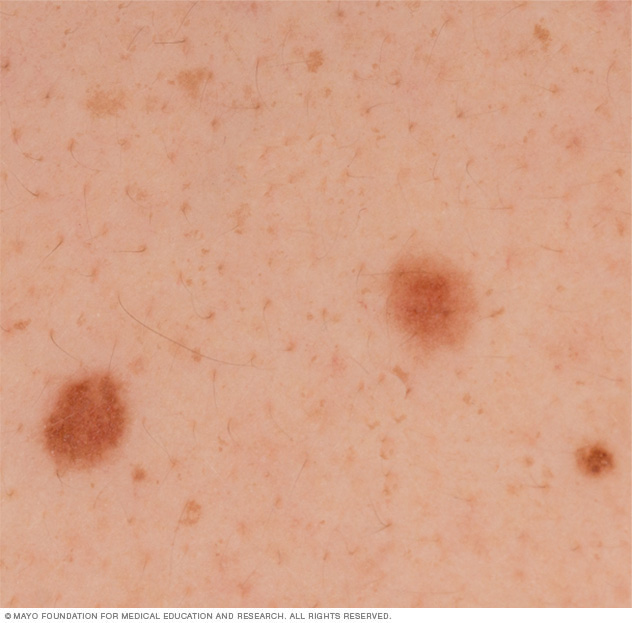
Moles are usually harmless. They may contain hairs or become raised or wrinkled. Talk to your doctor about any change in the color or size of a mole or if itching, pain, bleeding or inflammation develops.
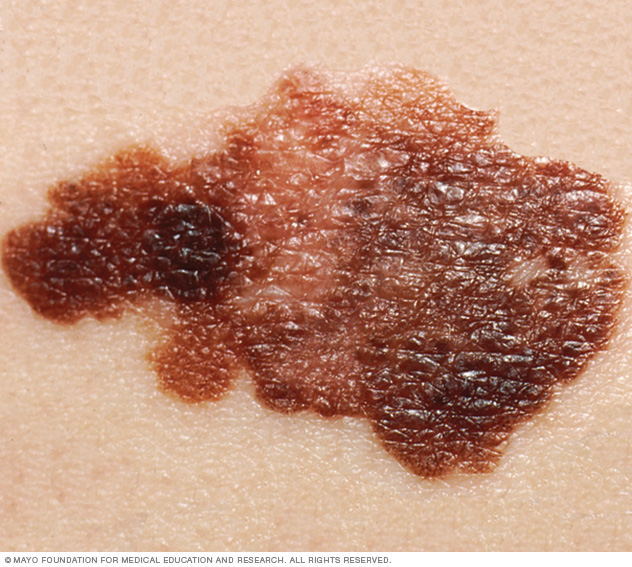
The first sign of melanoma is often a mole that changes size, shape or color. This melanoma shows color variations and an irregular border, both of which are melanoma warning signs.
Causes
Melanoma occurs when something goes wrong in the melanin-producing cells (melanocytes) that give color to your skin.
Normally, skin cells develop in a controlled and orderly way — healthy new cells push older cells toward your skin's surface, where they die and eventually fall off. But when some cells develop DNA damage, new cells may begin to grow out of control and can eventually form a mass of cancerous cells.
Just what damages DNA in skin cells and how this leads to melanoma isn't clear. It's likely that a combination of factors, including environmental and genetic factors, causes melanoma. Still, doctors believe exposure to ultraviolet (UV) radiation from the sun and from tanning lamps and beds is the leading cause of melanoma.
UV light doesn't cause all melanomas, especially those that occur in places on your body that don't receive exposure to sunlight. This indicates that other factors may contribute to your risk of melanoma.
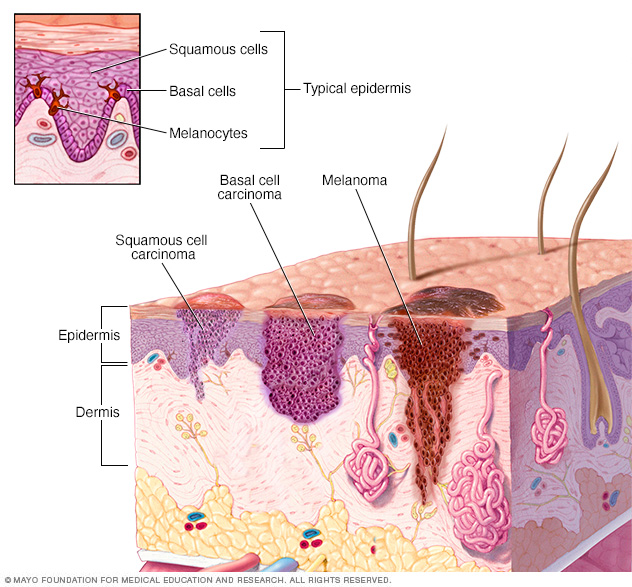
Skin cancer begins in the cells that make up the outer layer (epidermis) of your skin. One type of skin cancer called basal cell carcinoma begins in the basal cells, which make skin cells that continuously push older cells toward the surface. As new cells move upward, they become flattened squamous cells, where a skin cancer called squamous cell carcinoma can occur. Melanoma, another type of skin cancer, arises in the pigment cells (melanocytes).
Risk factors
Factors that may increase your risk of melanoma include:
- Fair skin. Having less pigment (melanin) in your skin means you have less protection from damaging UV radiation. If you have blond or red hair, light-colored eyes, and freckle or sunburn easily, you're more likely to develop melanoma than is someone with a darker complexion. But melanoma can develop in people with darker complexions, including Hispanic people and black people.
- A history of sunburn. One or more severe, blistering sunburns can increase your risk of melanoma.
- Excessive ultraviolet (UV) light exposure. Exposure to UV radiation, which comes from the sun and from tanning lights and beds, can increase the risk of skin cancer, including melanoma.
- Living closer to the equator or at a higher elevation. People living closer to the earth's equator, where the sun's rays are more direct, experience higher amounts of UV radiation than do those living farther north or south. In addition, if you live at a high elevation, you're exposed to more UV radiation.
- Having many moles or unusual moles. Having more than 50 ordinary moles on your body indicates an increased risk of melanoma. Also, having an unusual type of mole increases the risk of melanoma. Known medically as dysplastic nevi, these tend to be larger than normal moles and have irregular borders and a mixture of colors.
- A family history of melanoma. If a close relative — such as a parent, child or sibling — has had melanoma, you have a greater chance of developing a melanoma, too.
- Weakened immune system. People with weakened immune systems have an increased risk of melanoma and other skin cancers. Your immune system may be impaired if you take medicine to suppress the immune system, such as after an organ transplant, or if you have a disease that impairs the immune system, such as AIDS.
Prevention
You can reduce your risk of melanoma and other types of skin cancer if you:
-
Avoid the sun during the middle of the day. For many people in North America, the sun's rays are strongest between about 10 a.m. and 4 p.m. Schedule outdoor activities for other times of the day, even in winter or when the sky is cloudy.
You absorb UV radiation year-round, and clouds offer little protection from damaging rays. Avoiding the sun at its strongest helps you avoid the sunburns and suntans that cause skin damage and increase your risk of developing skin cancer. Sun exposure accumulated over time also may cause skin cancer.
- Wear sunscreen year-round. Use a broad-spectrum sunscreen with an SPF of at least 30, even on cloudy days. Apply sunscreen generously, and reapply every two hours — or more often if you're swimming or perspiring.
-
Wear protective clothing. Cover your skin with dark, tightly woven clothing that covers your arms and legs, and a broad-brimmed hat, which provides more protection than does a baseball cap or visor.
Some companies also sell protective clothing. A dermatologist can recommend an appropriate brand. Don't forget sunglasses. Look for those that block both types of UV radiation — UVA and UVB rays.
- Avoid tanning lamps and beds. Tanning lamps and beds emit UV rays and can increase your risk of skin cancer.
-
Become familiar with your skin so that you'll notice changes. Examine your skin often for new skin growths or changes in existing moles, freckles, bumps and birthmarks. With the help of mirrors, check your face, neck, ears and scalp.
Examine your chest and trunk and the tops and undersides of your arms and hands. Examine both the front and back of your legs and your feet, including the soles and the spaces between your toes. Also check your genital area and between your buttocks.
Diagnosis
Tests and procedures used to diagnose melanoma include:
- Physical exam. Your doctor will ask questions about your health history and examine your skin to look for signs that may indicate melanoma.
-
Removing a sample of tissue for testing (biopsy). To determine whether a suspicious skin lesion is melanoma, your doctor may recommend removing a sample of skin for testing. The sample is sent to a lab for examination.
What type of biopsy procedure your doctor recommends will depend on your particular situation. Most often doctors recommend removing the entire growth when possible. One common technique, the punch biopsy, is done with a circular blade that's pressed into the skin around the suspicious mole. Another technique, called an excisional biopsy, uses a scalpel to cut away the entire mole and a small margin of healthy tissue around it.
Determining the extent of the melanoma
If you receive a diagnosis of melanoma, the next step is to determine the extent (stage) of the cancer. To assign a stage to your melanoma, your doctor will:
Determine the thickness. The thickness of a melanoma is determined by carefully examining the melanoma under a microscope and measuring it with a special tool. The thickness of a melanoma helps doctors decide on a treatment plan. In general, the thicker the tumor, the more serious the disease.
Thinner melanomas may only require surgery to remove the cancer and some normal tissue around it. If the melanoma is thicker, your doctor may recommend additional tests to see if the cancer has spread before determining your treatment options.
-
See if the melanoma has spread to the lymph nodes. If there's a risk that the cancer has spread to the lymph nodes, your doctor may recommend a procedure known as a sentinel node biopsy.
During a sentinel node biopsy, a dye is injected in the area where your melanoma was removed. The dye flows to the nearby lymph nodes. The first lymph nodes to take up the dye are removed and tested for cancer cells. If these first lymph nodes (sentinel lymph nodes) are cancer-free, there's a good chance that the melanoma has not spread beyond the area where it was first discovered.
- Look for signs of cancer beyond the skin. For people with more-advanced melanomas, doctors may recommend imaging tests to look for signs that the cancer has spread to other areas of the body. Imaging tests may include X-rays, CT scans and positron emission tomography (PET) scans. These imaging tests generally aren't recommended for smaller melanomas with a lower risk of spreading beyond the skin.
Other factors may go into determining the risk that the cancer may spread (metastasize), including whether the skin over the area has formed an open sore (ulceration) and how many dividing cancer cells (mitoses) are found when looking under a microscope.
Melanoma is staged using the Roman numerals 0 through IV. At stage 0 and stage I, a melanoma is small and has a very successful treatment rate. But the higher the numeral, the lower the chances of a full recovery. By stage IV, the cancer has spread beyond your skin to other organs, such as your lungs or liver.
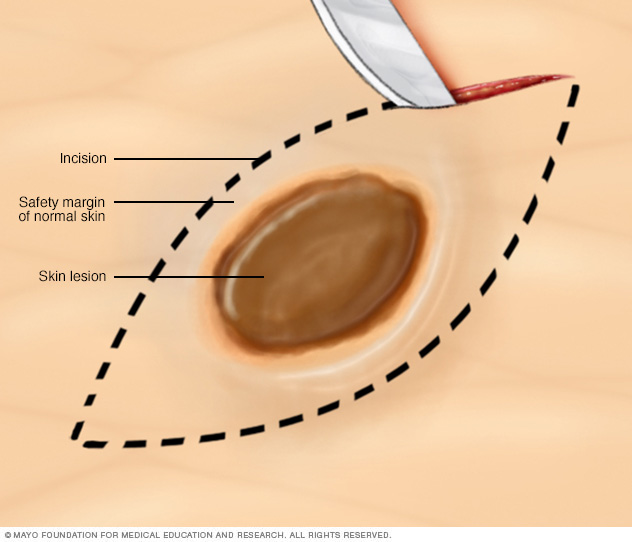
During an excisional biopsy, the doctor removes an entire lump or an entire area of abnormal skin, including a portion of normal skin. Stitches are generally used to close the biopsy site after this procedure.
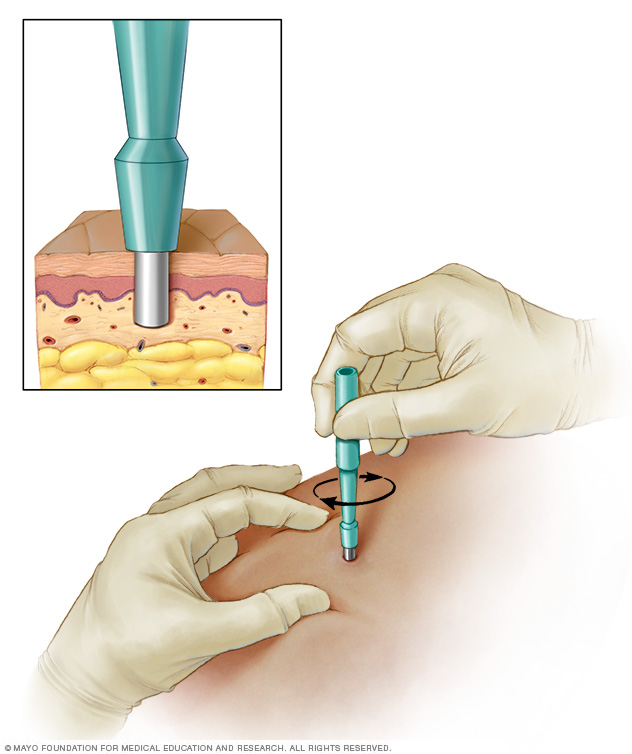
During a punch biopsy, your health care provider uses a special circular blade to remove deeper layers of skin for testing. Depending on the size, stitches may be necessary to close the wound.
Treatment
The best treatment for your melanoma depends on the size and stage of cancer, your overall health, and your personal preferences.
Treatment for small melanomas
Treatment for early-stage melanomas usually includes surgery to remove the melanoma. A very thin melanoma may be removed entirely during the biopsy and require no further treatment. Otherwise, your surgeon will remove the cancer as well as a border of normal skin and a layer of tissue beneath the skin. For people with early-stage melanomas, this may be the only treatment needed.
Treating melanomas that have spread beyond the skin
If melanoma has spread beyond the skin, treatment options may include:
- Surgery to remove affected lymph nodes. If melanoma has spread to nearby lymph nodes, your surgeon may remove the affected nodes. Additional treatments before or after surgery also may be recommended.
-
Immunotherapy. Immunotherapy is a drug treatment that helps your immune system to fight cancer. Your body's disease-fighting immune system might not attack cancer because the cancer cells produce proteins that help them hide from the immune system cells. Immunotherapy works by interfering with that process.
Immunotherapy is often recommended after surgery for melanoma that has spread to the lymph nodes or to other areas of the body. When melanoma can't be removed completely with surgery, immunotherapy treatments might be injected directly into the melanoma.
-
Targeted therapy. Targeted drug treatments focus on specific weaknesses present within cancer cells. By targeting these weaknesses, targeted drug treatments can cause cancer cells to die. Cells from your melanoma may be tested to see if targeted therapy is likely to be effective against your cancer.
For melanoma, targeted therapy might be recommended if the cancer has spread to your lymph nodes or to other areas of your body.
-
Radiation therapy. This treatment uses high-powered energy beams, such as X-rays and protons, to kill cancer cells. Radiation therapy may be directed to the lymph nodes if the melanoma has spread there. Radiation therapy can also be used to treat melanomas that can't be removed completely with surgery.
For melanoma that spreads to other areas of the body, radiation therapy can help relieve symptoms.
-
Chemotherapy. Chemotherapy uses drugs to kill cancer cells. Chemotherapy can be given intravenously, in pill form or both so that it travels throughout your body.
Chemotherapy can also be given in a vein in your arm or leg in a procedure called isolated limb perfusion. During this procedure, blood in your arm or leg isn't allowed to travel to other areas of your body for a short time so that the chemotherapy drugs travel directly to the area around the melanoma and don't affect other parts of your body.
Coping and support
A cancer diagnosis can change your life forever. Each person finds his or her own way of coping with the emotional and physical changes cancer brings. But when you're first diagnosed with cancer, sometimes it's difficult to know what to do next.
Here are some ideas to help you cope:
- Learn enough about melanoma to make decisions about your care. Ask your doctor about your cancer, including your treatment options and, if you like, your prognosis. As you learn more about cancer, you may become more confident in making treatment decisions.
- Keep friends and family close. Keeping your close relationships strong will help you deal with your cancer. Friends and family can provide the practical support you'll need, such as helping take care of your home if you're in the hospital. And they can serve as emotional support when you feel overwhelmed by cancer.
-
Find someone to talk with. Find a good listener who is willing to listen to you talk about your hopes and fears. This may be a friend or family member. The concern and understanding of a counselor, medical social worker, clergy member or cancer support group also may be helpful.
Ask your doctor about support groups in your area. Other sources of information include the National Cancer Institute and the American Cancer Society.
Preparing for an appointment
Start by seeing your family doctor if you notice any skin changes that concern you. Depending on your situation and the outcome of any tests, you may be referred to a doctor who specializes in skin diseases (dermatologist) or to a doctor who specializes in cancer treatment (oncologist).
Because appointments can be brief, and because there's often a lot to discuss, it's a good idea to be well prepared for your appointment. Here's some information to help you get ready and know what to expect from your doctor.
What you can do
- Be aware of any pre-appointment restrictions. At the time you make the appointment, be sure to ask if there's anything you need to do in advance, such as restrict your diet.
- Write down any symptoms you're experiencing, including any that may seem unrelated to the reason for which you scheduled the appointment.
- Make a list of all medications, vitamins or supplements you're taking.
- Take a family member or friend along. Sometimes it can be difficult to remember all the information provided during an appointment. Someone who accompanies you may remember something that you missed or forgot.
- Write down questions to ask your doctor.
Your time with your doctor is limited, so preparing a list of questions can help you make the most of your time together. List your questions from most important to least important, in case time runs out. For melanoma, some basic questions to ask your doctor include:
- Do I have melanoma?
- How large is my melanoma?
- How deep is my melanoma?
- Has my melanoma spread beyond the area of skin where it was first discovered?
- What additional tests do I need?
- What are my treatment options?
- Can any treatment cure my melanoma?
- What are the potential side effects of each treatment option?
- Is there one treatment you feel is best for me?
- How long can I take to decide on a treatment option?
- Should I see a specialist? What will that cost, and will my insurance cover it?
- Are there any brochures or other printed material that I can take with me? What websites do you recommend?
- What will determine whether I should plan for a follow-up visit?
In addition to the questions that you've prepared to ask your doctor, don't hesitate to ask other questions during your appointment.
Copyright © 1998-2025 Mayo Foundation for Medical Education and Research (MFMER). All rights reserved.